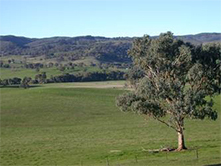Paddock trees and biodiversity
Isolated and small patches of trees - or paddock trees - are a prominent feature of agricultural landscapes in Australia. For the already highly cleared vegetation communities (e.g. Yellow Box), researchers, including researchers from OEH, have found that small patches of trees (up to 0.5 hectares) represent 40 per cent of remaining woodland cover and are therefore an extremely important focus for conservation and restoration efforts.
Research has also shown that large old paddock trees support more native birds and bats than individual trees within a woodland setting. The fauna take advantage of the different habitats within the cracks and hollows that form as the trees age.
However, isolated and small patches of trees are declining at a rapid rate, due to:
- natural ageing and death
- dieback, a sickness in trees which progresses from the tips of the shoots, along the branches, eventually to the trunk
- low rates of recruitment (regeneration)
Research has concluded that paddock trees could be lost from south east Australia within the next century.

Paddock tree, Image: Deb Saunders

Paddock tree, Image: Damon Oliver
| How to ‘estimate’ the age of a Yellow Box (Eucalyptus melliodora) tree |
| Diameter at breast height | Approximate age |
| 80 cm |
100 years old |
| 100 cm |
150 years old |
| 120 cm |
220 years old |
| 140 cm |
300 years old |
| 600 cm |
400 years old |
 |
Foldout A1 Brochure discussing why paddock trees are important, why they are disappearing and how they can be saved. Based on the work of Gibbons & Boak, 2002 (PDF 2.9MB) |
‘Scattered paddock trees fact sheet’ published by Central West Local Land Services in Dec 2014.
References
- Gibbons P, Boak M. 2002. The importance of paddock trees for conservation in agricultural landscapes. The value of paddock trees for regional conservation in an agricultural landscape. Ecological Management and Restoration 3: 205-210 (PDF 1.2MB)
- Gibbons P, Lindenmayer DB, Fischer J, Manning AD, Weinberg A, Seddon J, Ryan P, Barrett G. 2008. The Future of Scattered Trees in Agricultural Landscapes. Conservation Biology 22:5, 1309–1319 (PDF 769KB)
- Manning AD, Fischer J, Lindenmayer DB. 2005. Scattered trees are keystone structures – Implications for conservation. Biological Conservation 132 (2006) 311–321 (PDF 1MB)
- Manning, AD, Gibbons, P, Fischer, J, Oliver, DL and Lindenmayer, DB (2013). Hollow futures? Tree decline, lag effects and hollow-dependent species. Animal Conservation 16: 395-403
- Fischer J, Stott J, Zerger A, Waren G, Sherren K, Forrester R. 2009. Reversing a tree regeneration crisis in an endangered ecoregion. Proceedings of the National Academy of Sciences of the USA vol. 106:25
- Fischer J, Stott J, Law BS. 2010. The disproportionate value of paddock trees, Biological Conservation 143: 6 1564-1567
Page last updated: 27 July 2015